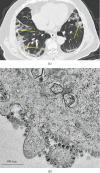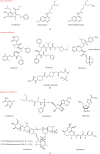Combating the Coronavirus Pandemic: Early Detection, Medical Treatment, and a Concerted Effort by the Global Community
- PMID: 32607499
- PMCID: PMC7315394
- DOI: 10.34133/2020/6925296
Combating the Coronavirus Pandemic: Early Detection, Medical Treatment, and a Concerted Effort by the Global Community
Abstract
The World Health Organization (WHO) has declared the outbreak of 2019 novel coronavirus, known as 2019-nCoV, a pandemic, as the coronavirus has now infected over 2.6 million people globally and caused more than 185,000 fatalities as of April 23, 2020. Coronavirus disease 2019 (COVID-19) causes a respiratory illness with symptoms such as dry cough, fever, sudden loss of smell, and, in more severe cases, difficulty breathing. To date, there is no specific vaccine or treatment proven effective against this viral disease. Early and accurate diagnosis of COVID-19 is thus critical to curbing its spread and improving health outcomes. Reverse transcription-polymerase chain reaction (RT-PCR) is commonly used to detect the presence of COVID-19. Other techniques, such as recombinase polymerase amplification (RPA), loop-mediated isothermal amplification (LAMP), clustered regularly interspaced short palindromic repeats (CRISPR), and microfluidics, have allowed better disease diagnosis. Here, as part of the effort to expand screening capacity, we review advances and challenges in the rapid detection of COVID-19 by targeting nucleic acids, antigens, or antibodies. We also summarize potential treatments and vaccines against COVID-19 and discuss ongoing clinical trials of interventions to reduce viral progression.
Copyright © 2020 Zichao Luo et al.
Conflict of interest statement
The authors declare no conflicts of interest.
Figures










Similar articles
-
Sensitive and rapid on-site detection of SARS-CoV-2 using a gold nanoparticle-based high-throughput platform coupled with CRISPR/Cas12-assisted RT-LAMP.Sens Actuators B Chem. 2021 Oct 15;345:130411. doi: 10.1016/j.snb.2021.130411. Epub 2021 Jul 6. Sens Actuators B Chem. 2021. PMID: 34248284 Free PMC article.
-
Development and Validation of a Novel COVID-19 nsp8 One-Tube RT-LAMP-CRISPR Assay for SARS-CoV-2 Diagnosis.Microbiol Spectr. 2022 Dec 21;10(6):e0196222. doi: 10.1128/spectrum.01962-22. Epub 2022 Nov 29. Microbiol Spectr. 2022. PMID: 36445095 Free PMC article.
-
Recent advances in methods for the diagnosis of Corona Virus Disease 2019.J Clin Lab Anal. 2022 Jan;36(1):e24178. doi: 10.1002/jcla.24178. Epub 2021 Dec 17. J Clin Lab Anal. 2022. PMID: 34921443 Free PMC article. Review.
-
Loop mediated isothermal amplification (LAMP) assays as a rapid diagnostic for COVID-19.Med Hypotheses. 2020 Aug;141:109786. doi: 10.1016/j.mehy.2020.109786. Epub 2020 Apr 25. Med Hypotheses. 2020. PMID: 32361529 Free PMC article.
-
[Recent advances in clustered regularly interspaced short palindromic repeats-based detection of severe acute respiratory syndrome coronavirus 2].Se Pu. 2022 Sep;40(9):773-781. doi: 10.3724/SP.J.1123.2022.08001. Se Pu. 2022. PMID: 36156623 Free PMC article. Review. Chinese.
Cited by
-
The Influence of Autoimmune Thyroid Diseases on Viral Pneumonia Development, Including COVID-19: A Two-Sample Mendelian Randomization Study.Pathogens. 2024 Jan 24;13(2):101. doi: 10.3390/pathogens13020101. Pathogens. 2024. PMID: 38392839 Free PMC article.
-
Sensitive and rapid on-site detection of SARS-CoV-2 using a gold nanoparticle-based high-throughput platform coupled with CRISPR/Cas12-assisted RT-LAMP.Sens Actuators B Chem. 2021 Oct 15;345:130411. doi: 10.1016/j.snb.2021.130411. Epub 2021 Jul 6. Sens Actuators B Chem. 2021. PMID: 34248284 Free PMC article.
-
SEB genotyping: SmartAmp-Eprimer binary code genotyping for complex, highly variable targets applied to HBV.BMC Infect Dis. 2022 Jun 3;22(1):516. doi: 10.1186/s12879-022-07458-4. BMC Infect Dis. 2022. PMID: 35659601 Free PMC article.
-
Collaborative and Structured Network for Maintenance of Mechanical Ventilators during the SARS-CoV-2 Pandemic.Healthcare (Basel). 2021 Jun 18;9(6):754. doi: 10.3390/healthcare9060754. Healthcare (Basel). 2021. PMID: 34207413 Free PMC article.
-
A Rapid SARS-CoV-2 RT-PCR Assay for Low Resource Settings.Diagnostics (Basel). 2020 Sep 24;10(10):739. doi: 10.3390/diagnostics10100739. Diagnostics (Basel). 2020. PMID: 32987722 Free PMC article.
References
-
- WHO. Coronavirus disease (COVID-19) outbreak situation. 2020. https://www.who.int/emergencies/diseases/novel-coronavirus-2019.
-
- WHO. 2019-nCoV outbreak is an emergency of international concern. 2020. http://www.euro.who.int/en/health-topics/health-emergencies/internationa.... - PMC - PubMed
-
- WHO. WHO Director-General's opening remarks at the media briefing on COVID-19. 2020. https://www.who.int/dg/speeches/detail/who-director-general-s-opening-re....
-
- Woo P. C., Lau S. K., Lam C. S., et al. Discovery of seven novel Mammalian and avian coronaviruses in the genus deltacoronavirus supports bat coronaviruses as the gene source of alphacoronavirus and betacoronavirus and avian coronaviruses as the gene source of gammacoronavirus and deltacoronavirus. Journal of Virology. 2012;86(7):3995–4008. doi: 10.1128/JVI.06540-11. - DOI - PMC - PubMed
Publication types
LinkOut - more resources
Full Text Sources
Miscellaneous

